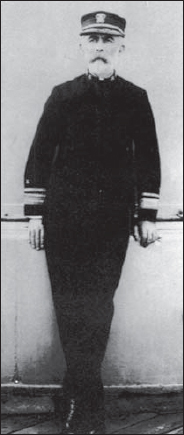
Before the Spanish American War, the American army was a small force of under 28,000 men, mainly serving in garrisons in the American West. Consisting of 25 infantry regiments and ten cavalry regiments, plus supporting artillery batteries, the army had only recently finished fighting the Indian Wars: thus many of the troops had gained combat experience. Standards of both training and recruitment were high, and the army was highly motivated. The regular army was augmented by the National Guard, a force of over 115,000 men. Although poorly equipped and of varying levels of proficiency, the guardsmen were a useful body with which to supplement the regular army in times of conflict. The National Guard’s usual role was in disaster relief, policing and, more notoriously, in quelling civil unrest and strike action. A quirk of the US army was the grouping of African-American regular troops into segregated ‘Negro’ regiments. The 24th and 25th Infantry and the 9th and 10th Cavalry were all classified as ‘Negro’ units, and these ‘Buffalo Soldiers’ had already served with distinction in the Indian Wars. All four regiments fought in Cuba.
Following the declaration of war, the army called for 125,000 volunteers to serve for two years, and recruiting offices across the country were inundated. Many National Guard units volunteered en bloc, forming supplementary battalions to existing regular regiments. By August, 56,000 regulars and 272,000 volunteers and guardsmen were in uniform. These troops were organised into seven corps, most of which saw service in Cuba, the Philippines, and Puerto Rico. Of these, I, II, III and VII Corps were mostly composed of volunteers, while V Corps consisted mainly of regulars. IV and VIII Corps were mixed.

Rear-Admiral William T. Sampson, commander of the US Atlantic Squadron, and senior American naval officer in Cuban waters. He was the architect of the Cuban blockade, and he commanded the fleet off Santiago. (Library of Congress)
The main problem with the American army in 1898 was not in its men, but in its logistical and command abilities. Corps and division-sized formations had not been used since the Civil War, and an army administration built to deal with the supply and outfitting of 27,000 men was faced with the need to supply ten times that number. Medical facilities were poor, and only the assistance of volunteer Red Cross nurses and doctors helped alleviate the situation.
The basic organisational unit in the US army was the regiment. In theory it consisted of three battalions, each of four companies. However, following the end of the Indian Wars, regiments were reduced to ten companies each, plus two cadre companies which served as recruiting and training units. In times of war, these units would be filled by volunteers, and the regiment would fight in three battalions. In reality, the regiments sent to Cuba were sent as ten-company units, and these all fought as a single battalion. On paper, the company numbered 140 officers and men, but in Cuba the regiments fought at less than half-strength (averaging 520 men per regiment). Volunteer and National Guard regiments were larger, and in Cuba the volunteer regiments had an average strength of 860 men apiece. Cavalry regiments were formed into three squadrons of four companies each, with a paper strength of 100 men per company. Only two squadrons per regiment were transported to Cuba, and these fought without their horses. The average strength of a cavalry regiment in Cuba was 400 men, while the 1st Volunteer Cavalry (Rough Riders) consisted of 600 men. Artillery was organised into administrative regiments, which included coastal batteries. In Cuba the artillery fought in independent four-gun batteries, with a strength of 70 men each.
The US army fought in uniforms that were completely unsuited to warfare in the tropics. Blue flannel shirts, brown wool trousers, canvas leggings, heavy leather shoes and a felt hat constituted a uniform that invited heat exhaustion. Cotton khaki uniforms were produced, but only reached the troops after the campaign was over. Regular troops were armed with the efficient Krag-Jorgensen bolt-action rifle. It fired a .3 in. (0.40 calibre) bullet, using a five-round clip. Its accuracy was comparable to the Spanish Mauser rifle, although it was less reliable in the field. The cavalrymen carried the Model 1896 Krag carbine. Supplies of Krag rifles were limited, so the volunteer infantry regiments were issued with the Trapdoor Springfield Model 1873, an obsolete weapon that used black powder cartridges. It was considered a danger to the firer as well as the target, as the cloud of smoke it emitted when used betrayed the firer’s position. The Krag and Mauser rifles of the regular troops used smokeless powder cartridges.

War correspondents in Tampa, Florida, including Stephen Crane (seated, second left) and Richard Harding Davis (standing, second left). Journalism would have a dramatic influence on the war. (National Archives)
The Spanish army had not fought a regular army since the Napoleonic Wars, but had been involved in an endless string of guerrilla wars and civil insurrections. As a result, it had become expert in counter-insurgency warfare. In both Cuba and the Philippines, the Spanish army performed well in this role, and by 1898 it was a proven and experienced anti-guerrilla force. Unfortunately, it was not prepared for a war against a conventional opponent, and the troops in Cuba lacked proper artillery support and experience in operating in large formations.
The war exposed other flaws in the army. Junior officers were often in their late teens, and products of the Spanish military academy. Others, promoted through the ranks, could be much older. The ratio of officers to men was unusually high, averaging one officer to every six enlisted men, or four times the ratio found in the American army. Immense social differences made the gulf between officer and soldier similar to that encountered in Russian armies of the same period. The soldiers, mostly in their early 20s, were for the most part poorly educated and lacking in initiative. During the war they also displayed remarkable courage and tenacity, earning praise from their opponents.
The Spanish army was organised into regiments for administrative purposes only, the battalion being the standard tactical unit. A regiment consisted of two battalions of six companies each. The paper listing of 160 officers and men per company was often under-strength in reality, particularly if serving away from its recruiting area. A full-strength battalion therefore contained around 1,000 men, although numbers varied between different types of infantry battalion. The usual practice was that one battalion in a regiment would remain in Spain and serve as the depot battalion for the other battalion on foreign service. Formations were labelled by origin or purpose: Colonial (Cuban, Puerto Rican or Philippine) or Peninsular (Spain itself) being the most common. Others, carrying the titles ‘Expeditionary’ or ‘Rifle’, were considered more specialist formations, while ‘Provincial’ troops were local militia formations raised in the colonies. ‘Volunteer’ units were smaller forces raised specifically to provide local garrison troops. Battalions on active service also raised ‘guerrilla’ companies from volunteers, and these served as specialist counter-insurgency forces of less than 50 men apiece. A typical garrison in Cuba would contain one mounted and one foot guerrilla company. Artillery batteries of four guns each were often split into sections and scattered throughout Cuba. The 160,000 Spanish troops in Cuba at the outbreak of the war were divided into 120 infantry battalions, ten cavalry regiments, 18 artillery batteries and two engineer battalions. Most of the specialist troops including the cavalry were grouped around Havana, and took no part in the San Juan campaign.
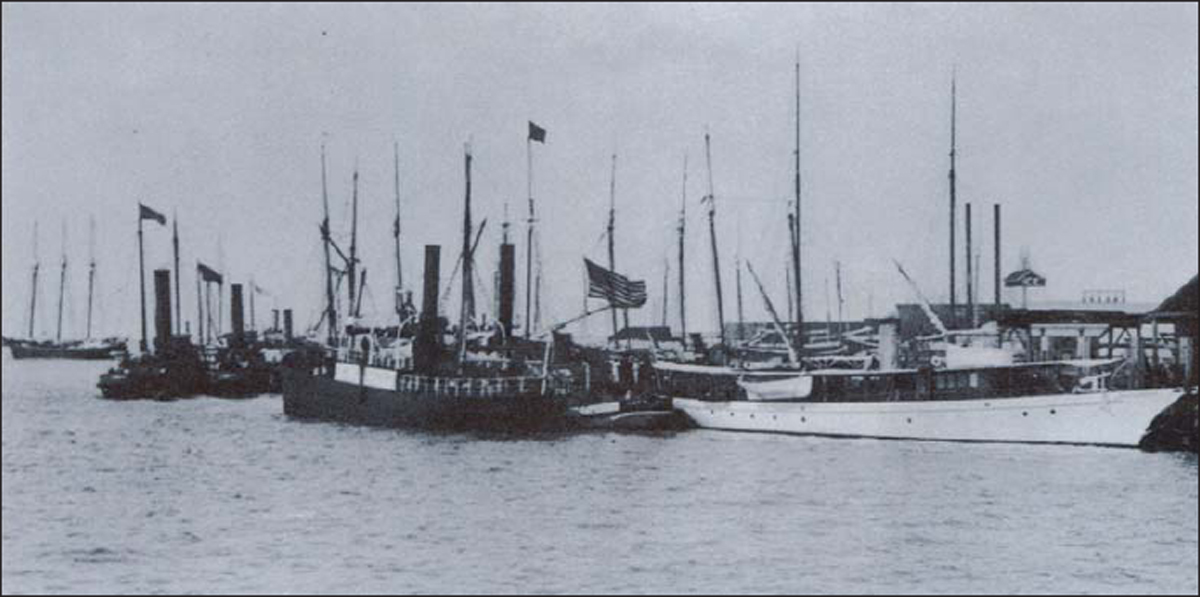
Newspaper launches and naval supply vessels in the harbour of Key West, Florida, June 1898. The town would prove to be of vital strategic importance during the war, and good telegraph links ensured that reporters could file their stories quickly. (National Archives)
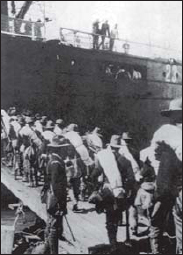
Soldiers of the 71st New York Volunteer Infantry Regiment boarding the transport Vigilancia at the port of Tampa, Florida. The heavy blanket rolls were discarded before going into battle. (National Archives)
Tactically, they placed an emphasis on fortified positions, and, at least in Cuba, these took the form of the widespread use of entrenchments, barbed wire and rifle pits. Troops would sally out from these secure positions in mobile, fast-moving columns, returning after a search-and-destroy operation or a regional sweep. A system of blockhouses was also used to provide security over a wider area, and these positions held by small garrisons provided warning of the movement of guerrilla forces in the countryside.
The Spanish infantryman was dressed in a lightweight cotton uniform of blue and white stripes and a straw hat, ideally suited to the Cuban climate. Leather boot footwear was often replaced by sandals or moccasins. Webbing consisted of small cartridge pouches mounted on a tan leather belt. A blanket was issued for bedding, and was often worn slung over the shoulder. The Spanish uniform was therefore superior to that of the American soldier, in that it was designed for use in the tropics. The Spanish soldier was also well armed. Each infantryman carried an 1893 Model Spanish Mauser rifle, a bolt-action weapon with a five-cartridge clip. It fired its 7mm rounds with great accuracy, had a knife-bayonet, and was similar to the Mauser rifles carried by the German army in both world wars.
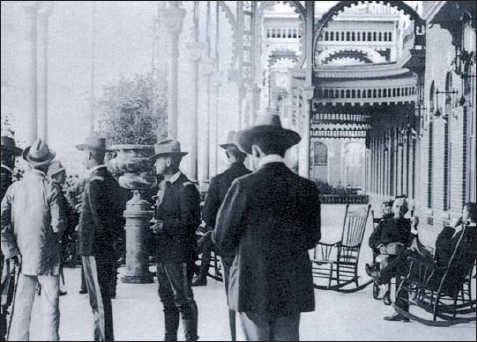
Staff officers from V Corps and newspaper correspondents on the steps of the Henry B. Plant Hotel, Tampa, Florida. The luxury hotel served as the headquarters for Gen. Shafter’s Corps: journalists dubbed this period ‘the Rocking Chair War’. (National Archives)
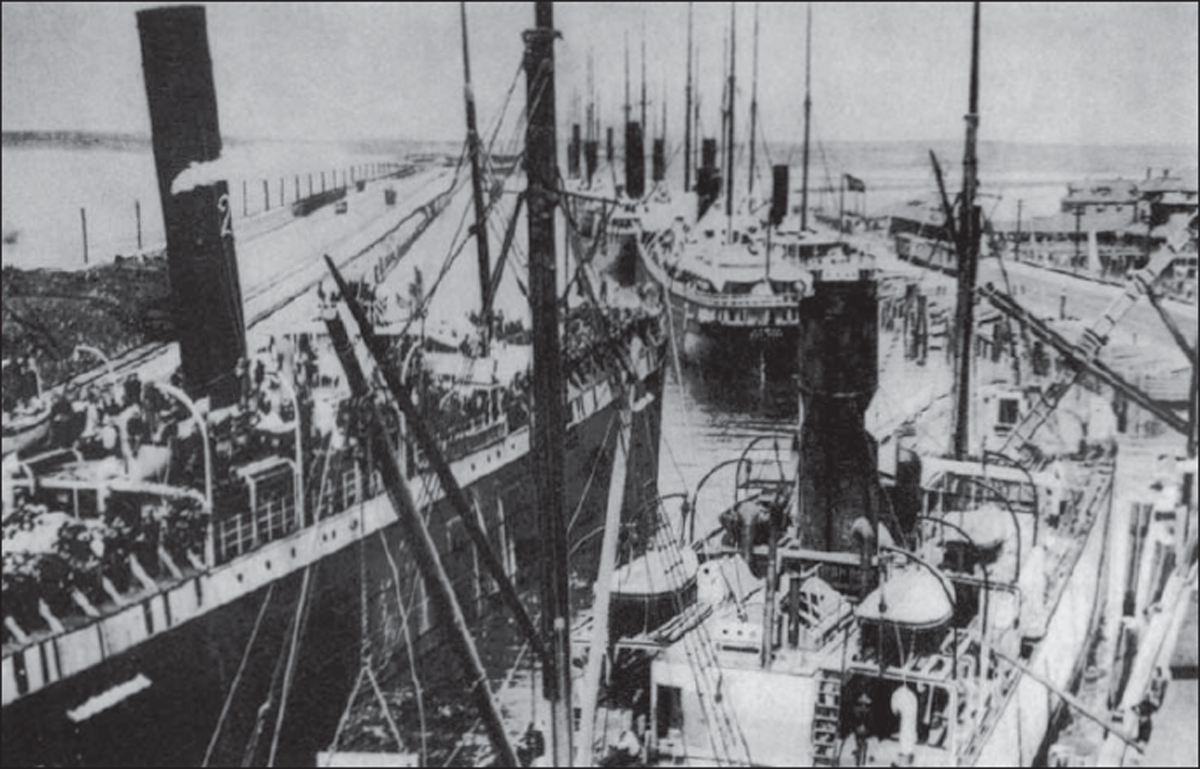
Loaded transports preparing to leave Tampa, Florida. The troops waited for several days aboard these cramped vessels before they were allowed to sail. (National Archives)
The American government had prepared contingency plans for a war with Spain, and these were brought out and studied. President McKinley left much of the strategic planning to the experts and was content to give his generals and admirals as much political freedom of action as he could. In the months preceding the outbreak of war, several tentative proposals had been discussed. The American strategic plan was to establish a naval blockade of Cuba, neutralise the Spanish fleet, then transport an expeditionary force to the island. Once there, it would work in concert with the Cuban insurgents to defeat the Spanish army, capture at least one leading city, and so force the Spanish to give up the struggle.
At the same time, Admiral Dewey in the Pacific would destroy the Spanish naval squadron based at Manila, leaving the way open for an American invasion of the Philippines. A subsidiary attack on Puerto Rico would strip Spain of all her overseas possessions. The main theatre of operation would be Cuba, and it proved to be where the decisive engagement of the war was fought. In May, President McKinley approved a plan for an offensive against Havana, where 70,000 US troops would be put ashore within 12 miles of the city. Maj.Gen. Nelson Miles, in charge of the army, was doubtful of the success of an assault on Havana, the best defended area in Cuba. The appearance of Admiral Cervera’s Spanish squadron at Santiago forced the American planners to rethink. The capture of both Santiago (Cuba’s second largest city) and the Spanish squadron was a better prospect than a direct assault on Havana itself. Within days the orders were given to ship V Corps to Santiago.
The Spanish had 160,000 troops in Cuba, the majority grouped around Havana. The movement of troops within Cuba by road and rail was severely disrupted by Cuban insurgent attacks, so little strategic flexibility was possible, and the commander of each military province would be forced to fight on his own. In Santiago, Gen. Linares commanding Oriente Province had 35,000 men under him, 10,500 of whom were in the vicinity of the city. Harbour defences were inadequate, with many of the guns hopelessly obsolete. Press leaks informed the Spanish that Santiago would be the target of the invasion, and steps were taken to improve the defences. Linares planned to harass the Americans as they approached the city, then pin them against the line of fortifications surrounding Santiago. The annual outbreak of yellow fever was due to start within the following two months; the longer the city could hold out, the worse the plight of the invaders. Once Spanish reinforcements and supplies had fought their way through to the region, the Spanish could counterattack and force the Americans back to their boats. Yellow fever would be the Spaniards’ secret weapon, as excessive casualties from combat and disease would quickly satiate the American public’s appetite for war.
Shafter, on the other hand, appeared to have no concrete plan when he sailed for Santiago. Once there, he would confer with Admiral Sampson, meet with Cuban insurgent leaders and then decide how to proceed. Shafter was well aware of the threat yellow fever posed to the troops under his command. Whatever plan he adopted, the campaign would have to be resolved as quickly as possible before disease and Spanish reinforcements shifted the balance of power any further. In short, the two opposing plans are best summed up as being ‘let’s see what happens’ and ‘let’s see what can happen, then make it happen quickly’.
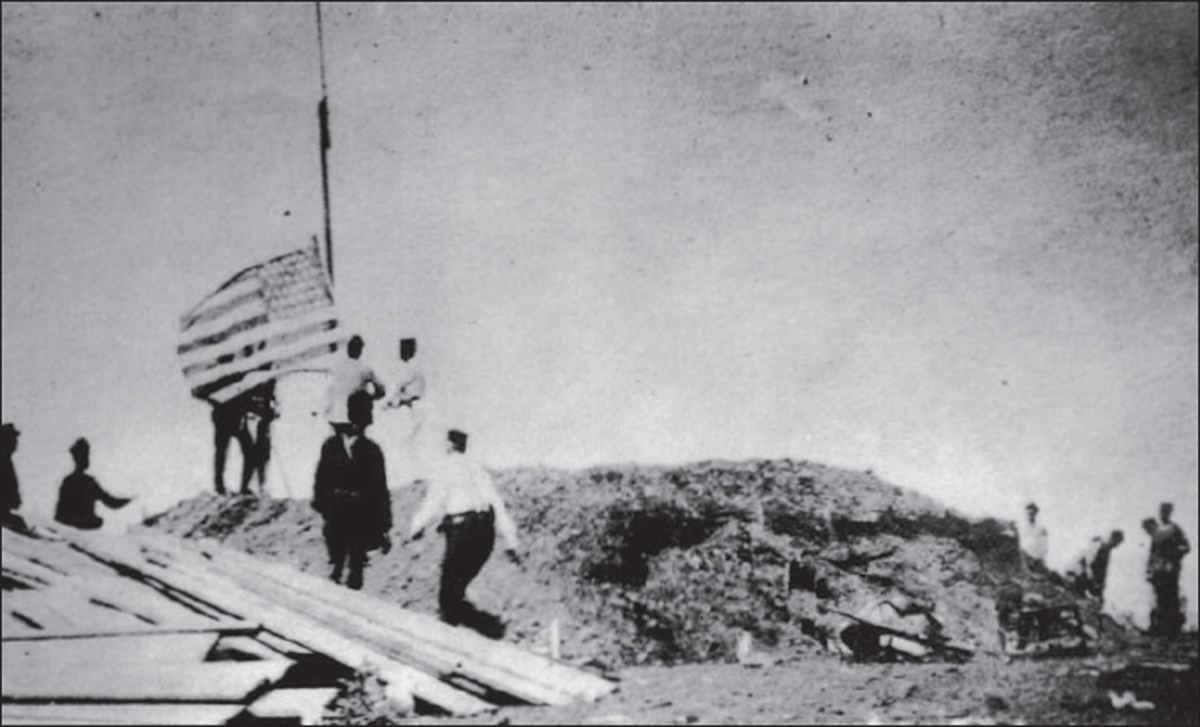
US Marines hoisting the American flag above the earthworks of Camp McCalla, the Marine foothold in Cuba at Guantanamo Bay. The bay would serve as a secure coaling station for the US navy. (US navy)